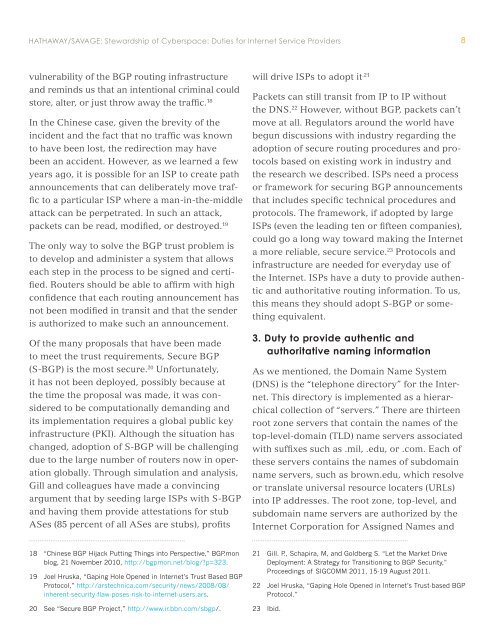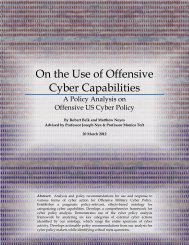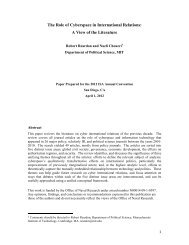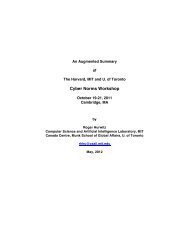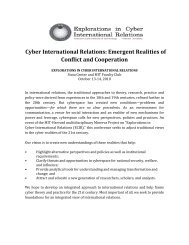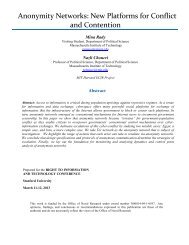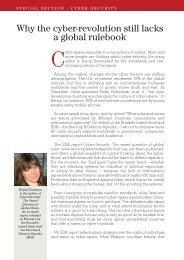Stewardship of Cyberspace: Duties for Internet Service Providers
Stewardship of Cyberspace: Duties for Internet Service Providers
Stewardship of Cyberspace: Duties for Internet Service Providers
You also want an ePaper? Increase the reach of your titles
YUMPU automatically turns print PDFs into web optimized ePapers that Google loves.
HATHAWAY/SAVAGE: <strong>Stewardship</strong> <strong>of</strong> <strong>Cyberspace</strong>: <strong>Duties</strong> <strong>for</strong> <strong>Internet</strong> <strong>Service</strong> <strong>Providers</strong> 8<br />
vulnerability <strong>of</strong> the BGP routing infrastructure<br />
and reminds us that an intentional criminal could<br />
store, alter, or just throw away the traffic. 18<br />
In the Chinese case, given the brevity <strong>of</strong> the<br />
incident and the fact that no traffic was known<br />
to have been lost, the redirection may have<br />
been an accident. However, as we learned a few<br />
years ago, it is possible <strong>for</strong> an ISP to create path<br />
announcements that can deliberately move traf-<br />
fic to a particular ISP where a man-in-the-middle<br />
attack can be perpetrated. In such an attack,<br />
packets can be read, modified, or destroyed. 19<br />
The only way to solve the BGP trust problem is<br />
to develop and administer a system that allows<br />
each step in the process to be signed and certi-<br />
fied. Routers should be able to affirm with high<br />
confidence that each routing announcement has<br />
not been modified in transit and that the sender<br />
is authorized to make such an announcement.<br />
Of the many proposals that have been made<br />
to meet the trust requirements, Secure BGP<br />
(S-BGP) is the most secure. 20 Un<strong>for</strong>tunately,<br />
it has not been deployed, possibly because at<br />
the time the proposal was made, it was con-<br />
sidered to be computationally demanding and<br />
its implementation requires a global public key<br />
infrastructure (PKI). Although the situation has<br />
changed, adoption <strong>of</strong> S-BGP will be challenging<br />
due to the large number <strong>of</strong> routers now in oper-<br />
ation globally. Through simulation and analysis,<br />
Gill and colleagues have made a convincing<br />
argument that by seeding large ISPs with S-BGP<br />
and having them provide attestations <strong>for</strong> stub<br />
ASes (85 percent <strong>of</strong> all ASes are stubs), pr<strong>of</strong>its<br />
18 “Chinese BGP Hijack Putting Things into Perspective,” BGP.mon<br />
blog, 21 November 2010, http://bgpmon.net/blog/?p=323.<br />
19 Joel Hruska, “Gaping Hole Opened in <strong>Internet</strong>’s Trust Based BGP<br />
Protocol,” http://arstechnica.com/security/news/2008/08/<br />
inherent-security-flaw-poses-risk-to-internet-users.ars.<br />
20 See “Secure BGP Project,” http://www.ir.bbn.com/sbgp/.<br />
will drive ISPs to adopt it .21<br />
Packets can still transit from IP to IP without<br />
the DNS. 22 However, without BGP, packets can’t<br />
move at all. Regulators around the world have<br />
begun discussions with industry regarding the<br />
adoption <strong>of</strong> secure routing procedures and pro-<br />
tocols based on existing work in industry and<br />
the research we described. ISPs need a process<br />
or framework <strong>for</strong> securing BGP announcements<br />
that includes specific technical procedures and<br />
protocols. The framework, if adopted by large<br />
ISPs (even the leading ten or fifteen companies),<br />
could go a long way toward making the <strong>Internet</strong><br />
a more reliable, secure service. 23 Protocols and<br />
infrastructure are needed <strong>for</strong> everyday use <strong>of</strong><br />
the <strong>Internet</strong>. ISPs have a duty to provide authen-<br />
tic and authoritative routing in<strong>for</strong>mation. To us,<br />
this means they should adopt S-BGP or some-<br />
thing equivalent.<br />
3. Duty to provide authentic and<br />
authoritative naming in<strong>for</strong>mation<br />
As we mentioned, the Domain Name System<br />
(DNS) is the “telephone directory” <strong>for</strong> the Inter-<br />
net. This directory is implemented as a hierar-<br />
chical collection <strong>of</strong> “servers.” There are thirteen<br />
root zone servers that contain the names <strong>of</strong> the<br />
top-level-domain (TLD) name servers associated<br />
with suffixes such as .mil, .edu, or .com. Each <strong>of</strong><br />
these servers contains the names <strong>of</strong> subdomain<br />
name servers, such as brown.edu, which resolve<br />
or translate universal resource locaters (URLs)<br />
into IP addresses. The root zone, top-level, and<br />
subdomain name servers are authorized by the<br />
<strong>Internet</strong> Corporation <strong>for</strong> Assigned Names and<br />
21 Gill. P., Schapira, M, and Goldberg S. “Let the Market Drive<br />
Deployment: A Strategy <strong>for</strong> Transitioning to BGP Security,”<br />
Proceedings <strong>of</strong> SIGCOMM 2011, 15-19 August 2011.<br />
22 Joel Hruska, “Gaping Hole Opened in <strong>Internet</strong>’s Trust-based BGP<br />
Protocol.”<br />
23 Ibid.


